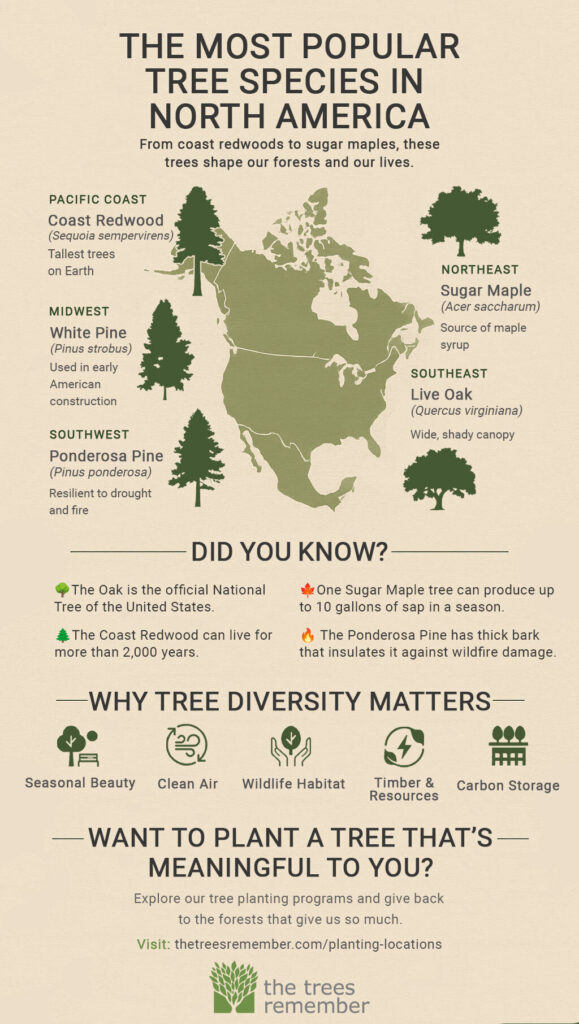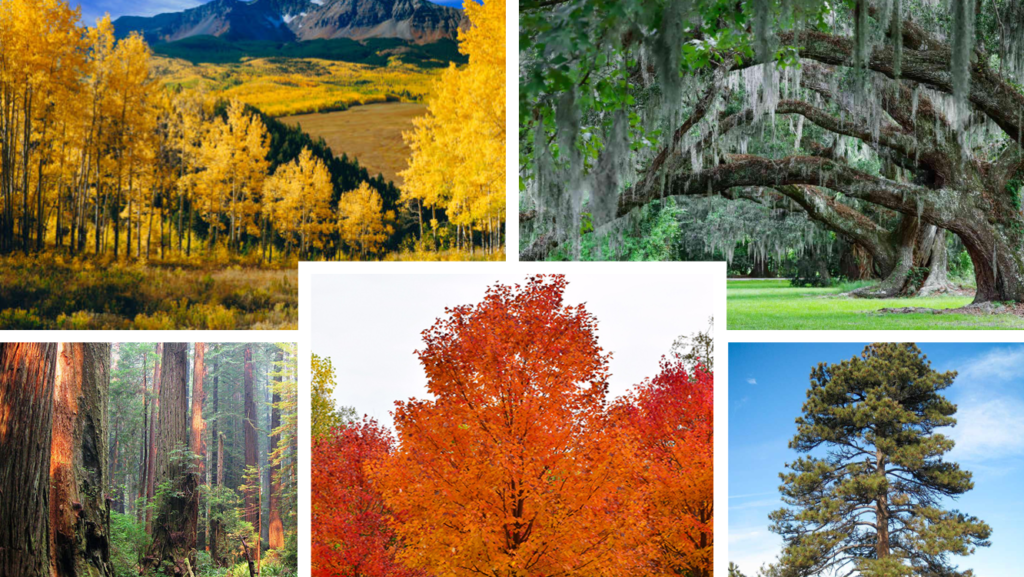The Most Popular Tree Species in North America
North America is home to a breathtaking variety of trees, each shaping the landscapes, ecosystems, and cultures that define the continent. From the towering redwoods of the West Coast to the resilient birches of the Northeast, these trees do more than provide shade and beauty—they sustain wildlife, regulate the climate, and enrich human lives. In this post, we’ll explore some of North America’s most iconic tree species and their vital ecological roles. We’ll also highlight the top trees used in reforestation projects, explaining how they help restore forests and combat climate change.

Iconic Trees of North America
- Coast Redwood (Sequoia sempervirens)
This true giant of the forest dominates the coastal regions of California. The coast redwood is one of the most iconic trees in North America. Growing over 350 feet tall and living for more than 2,000 years, these trees are some of the oldest and tallest on Earth. Redwoods provide critical habitat for species like the marbled murrelet and northern spotted owl, making them vital to the North American forest ecosystems. - Sugar Maple (Acer saccharum)
A fall favorite, the sugar maple paints the forests of the northeastern U.S. and southeastern Canada in brilliant shades of red, orange, and gold. Beyond its dazzling autumn display, this tree plays a crucial role in maple syrup production and provides vital habitat for pollinators. Its dense canopy also offers cooling shade, benefiting both urban and rural environments. - Ponderosa Pine (Pinus ponderosa)
Thriving across the western United States, the ponderosa pine is a symbol of resilience. Its thick bark allows it to withstand wildfires, a crucial adaptation in fire-prone landscapes. The tree supports a variety of wildlife, from woodpeckers to black bears, and plays a key role in stabilizing soils in mountainous regions. - Southern Live Oak (Quercus virginiana)
A beloved sight in the southeastern U.S., the southern live oak is often draped in Spanish moss, creating the quintessential Southern landscape. These sturdy trees offer food and shelter for birds, squirrels, and insects while providing essential shade in hot climates. Their strong, sprawling branches also make them a favorite for climbing and relaxation. - Aspen (Populus tremuloides)
Nicknamed the “quaking aspen” for the way its leaves tremble in the wind, this tree thrives in the Rocky Mountains and high-altitude forests. Aspen trees grow in massive clonal colonies, meaning an entire grove can originate from a single parent tree. This unique growth pattern helps prevent soil erosion and supports a diverse range of wildlife.
Top Tree Species for Reforestation in the United States
Reforestation projects focus on planting native tree species that thrive in specific ecosystems while providing maximum ecological benefits. Here are some of the most commonly used species for reforestation:
Longleaf Pine
Once covering over 90 million acres in the southeastern U.S., the longleaf pine now occupies less than 3% of its historic range. This tree is vital for nearly 600 species, including the endangered red-cockaded woodpecker and gopher tortoise. With its natural resistance to fire, drought, and pests, the longleaf pine is a top choice for restoring degraded lands.
Douglas Fir
One of the most widely planted trees in North America, the Douglas fir thrives in the Pacific Northwest and other western regions. This fast-growing species provides habitat for wildlife such as elk, black bears, and countless bird species. Its ability to sequester carbon efficiently also makes it a key player in climate change mitigation.
Bald Cypress
Found in the wetlands of the southeastern U.S., the bald cypress is a lifeline for swamp ecosystems. It helps stabilize riverbanks, reduce erosion, and filter water, making it essential for wetland restoration. It also provides nesting sites for wading birds, amphibians, and fish.
Black Walnut
Native to forests in the eastern and central U.S., the black walnut is valued both for its rich, durable wood and its role as a keystone species. Its nutrient-rich nuts support a variety of wildlife, from squirrels to turkeys, while its deep roots prevent soil erosion.
Western Larch
A deciduous conifer, the western larch thrives in the cold mountain ranges of the northwestern U.S. This tree’s ability to shed its needles in winter reduces snow buildup on branches, preventing breakage. It plays a key role in soil stabilization and wildfire resistance, making it a vital species for reforestation projects in mountainous areas.
How North American Reforestation Supports a Healthier Global Ecosystem
Reforestation efforts do more than plant trees, they restore entire ecosystems. Planting native trees in reforestation projects helps combat climate change, restore wildlife habitats, and improve air and water quality. By carefully selecting species suited to specific regions, reforestation ensures that forests can thrive. For example, Douglas firs store large amounts of carbon, longleaf pines provide safe nesting grounds for endangered birds, and bald cypress trees protect wetlands from erosion. Every tree planted in North America is a step toward a healthier planet.
Planting a tree is more than an act of conservation—it’s a legacy. Whether honoring a loved one, celebrating a milestone, or simply giving back to nature, your contribution helps restore forests and protect wildlife. Join us in making a difference.
Take Action, Plant Trees for the Future
Choose to plant trees and contribute to the health of North America’s forests and ecosystems. The Trees Remember partners with organizations to plant native trees in areas that need them most. By supporting reforestation, you’re helping to combat climate change, restore habitats, and creating a greener future.

